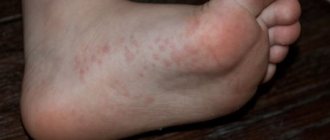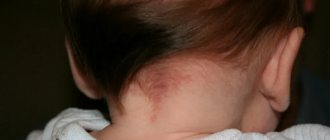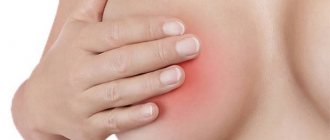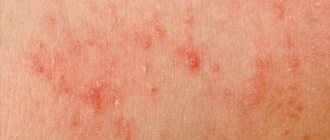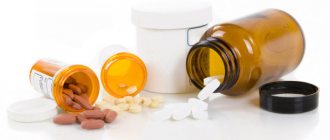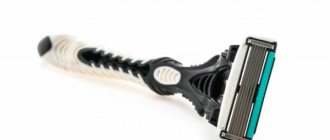Causes of red spots
Often, red spots appear as a reaction to an irritant, virus or infection.
Possible reasons are: 1. Allergies
. Its appearance is provoked by:
- chemicals
. Contact with them causes an allergic reaction, which manifests itself quite quickly in the form of red spots. An irritant can be any substance that is in constant use: from decorative cosmetics to household detergents and cleaners.Red spots also occur under the influence of physical factors such as sunlight, wind or cold;
- food or medicines
.
Their irritating effect leads to the appearance of urticaria
, a disease in which pale pink blisters appear on the skin. The most typical allergens are exotic (and not only) fruits and berries, chocolate, eggs. The list of medications that can lead to the manifestation of urticaria includes antibiotics, gamma globulins, and serums. The disease may be a manifestation of some other disease, and not just an independent allergic reaction.
2. Infectious diseases
- another cause of red spots. With such diseases, skin rashes are accompanied by an increase in temperature, intoxication syndrome, and catarrhal manifestations. Red spots are multiple and have a characteristic location. The most common diseases in which the skin becomes covered with them are: viral diseases: measles and chicken pox, scarlet fever and meningitis; occasionally the presence of red spots is the first sign of typhoid fever;
- pyoderma
. The disease develops through the introduction of pyogenic cocci into the epidermis. It occurs on healthy skin or is a complication of other diseases. The development of pyoderma can be provoked by minor injuries (cuts, scratches, bites), skin contamination, hypothermia or overheating. Disturbances in the functioning of the nervous system, metabolic failures, and pathologies of internal organs predispose to the disease.The disease manifests itself with many symptoms, including red spots. They may peel, but not itch. The spots are painful to the touch;
- Ringworm
is an infectious disease of a fungal nature. Its manifestations are pronounced: the skin is covered with large red round spots. Each of them is surrounded by small bubbles. In the center of the spots, the skin is more intensely colored; - pityriasis rosea
(Giber's disease) is an infectious-allergic disease.In spring or autumn, pink spots of significant size - 4-5 cm - may appear on the body. Their contours are clearly defined and may rise slightly. The spots flake, but do not itch. The person feels slightly unwell, muscle pain and lethargy. The cause of pityriasis rosea is herpes types 6 and 7, although this has not been precisely established.
There are other fungal diseases that cause the appearance of red and pink spots.
3. Dermatological diseases
- a common cause of their occurrence. The most common ones are:
- psoriasis
is a non-infectious disease. It occurs in a chronic form. Red and excessively dry spots called papules form on the skin. They rise slightly above the surface and merge with each other. The spots become covered with a flaky crust and cause discomfort. It has been established that the immune system plays a decisive role in the development of the disease; - eczema
is a non-contagious disease. It is an inflammatory disease of the skin, occurring in acute and chronic forms. The body is covered with a variety of rashes in the form of red spots. They are flaky and itchy. Eczema appears under the influence of external factors (thermal, mechanical, chemical) and internal (pathologies of the kidneys and liver, diseases of the nervous and endocrine systems). There are several types of disease, differing in etiology, nature of skin manifestations and localization; - Rosacea
, or rosacea, is a chronic facial skin disease. It is characterized by redness and dilation of superficial small vessels. Stars and red spots appear on the cheeks, nose and forehead. As a rule, the disease is hereditary. It first manifests itself in adolescence. But you can get rosacea even in adulthood if you indulge in strong drinks, consume a lot of spices and visit the sauna, bathhouse or solarium too often.
There are other dermatological diseases that are distinguished by the appearance of pink and red spots on the skin. Only a doctor can carry out a correct and complete diagnosis of ailments.
Treatment of itchy skin with folk remedies
Since most skin diseases are accompanied by painful itching, a fair question arises: how to deal with it?
- An effective and simple remedy is apple cider vinegar, which should be used to wipe problem areas.
- For insect bites, plantain leaf, dandelion juice or an ice cube will help.
- If red spots appear on your hands that itch, lemon balm infusion is useful. Take a tablespoon of dried lemon balm for a glass of boiling water, leave it in a thermos for an hour and a half, and drink two or three glasses a day.
- Infusion of celandine can be used to treat problem areas of the skin and make lotions. One teaspoon of dried celandine is required per glass of boiling water.
- Compress or bath with chamomile infusion.
- Warm bath with added sea salt.
- Apply the pulp of an aloe leaf to the itchy area for 20 minutes.
- Propolis ointment, 1-2% mumiyo solution, menthol oil quickly relieves itching.
This article looked at why red spots may appear on the skin of the hands. The variety of diseases that cause red spots encourages you not to self-medicate, but to consult a doctor. Only a dermatologist will make the correct diagnosis and prescribe the therapy that is most suitable for you.
In men, the skin on the inside between the legs sometimes becomes blotchy and becomes very itchy and flaky.
You should pay close attention to this, since most likely it is an infection or the skin disease athlete's foot. Rough small spots between the fingers that itch very much can also become a sign of scabies, since it is between the fingers that the first localization of this infection appears
Treatment options
If large or small, smooth or rough red spots appear on the skin that itch or flake, then the first thing to do is to find out the cause of their occurrence.
If you find red spots or a rash on your body, do not self-medicate, but go to a dermatologist.
Allergic spots
If the symptom is caused by poor diet or food allergies, then you should simply review your diet and exclude from it all possible foods that are harmful to the skin. In case of allergies, after testing for the allergen, the attending physician will prescribe a suitable antihistamine. Effective drugs for topical use are Fenistil, Gistan, Ketopin.
Stress
If rough spots on the face, hands, between the fingers and on the body are caused by constant nervous overstrain, then calming sedatives will come to the rescue. The doctor will select the most effective one, and it is better if it is a natural-based drug, for example, Novo-passit, motherwort tincture, Persen. Try to bring more peace into your life and, if possible, eliminate external irritants.
Dry skin
If redness and spots are caused by dry skin, hypothermia. Then use drugs and natural remedies, for example:
- warm olive oil;
- chamomile decoction;
- Dermalibur cream;
- Traumeel ointment;
- Radevit – fortified ointment;
- Epithelial cream with oat milk;
- Bepanten ointment.
If the spots are caused by hypothermia, a good home remedy would be a salt bath with mint infusion and sage essential oil. Use sea salt for this purpose, and after the procedure, be sure to use nourishing hand cream.
Diseases
It is impossible to recommend a universal medicine or prescription for red spots on the face, arms or legs, since the causes of the symptom are different. The best advisor in such a situation, of course, is a dermatologist. Depending on the disease or malfunction in the body, he will prescribe the appropriate remedy, for example:
- Psoriaten - an ointment used for psoriasis to eliminate scaly spots;
- hormonal ointments with prednisolone or hydrocortisone are indicated if other drugs are ineffective;
- Iricar for eczema;
- Medifox, Benzyl benzoate for scabies;
- Sulsen, Mikoseptin for the treatment of lichen.
Sun spots
It often happens that red spots appear on the face and body after prolonged exposure to the open sun, the nose is especially susceptible to this. It could be a simple burn or an allergy to the rays of the sun. In case of a burn, use special after-sun oils and creams. And also with natural remedies - cool sour cream, potato starch, olive oil. If the red spots are nothing more than an allergy to the ultraviolet radiation of the sun, then creams with lanolin, zinc are usually prescribed; in more severe cases, ointments with hormones, and home remedies include applications of fresh cucumber, potato, and cabbage gruel.
Should I see a doctor?
It is recommended to visit a doctor in any case, even if there is a red spot that does not itch or hurt. The dermatologist will conduct an examination and questioning, prescribe additional examination if necessary and tell you how to get rid of red dots on the body. Most often, you need to take a general blood test and a scraping from the affected area; a little less often, tissue is taken for a biopsy. Diagnosis of the disease is difficult; self-medication is extremely undesirable, so as not to harm your health.
Ways to deal with red spots that don't itch
If a dermatological disease is detected, the doctor prescribes local treatment - ointments, herbal baths.
Comprehensive examination and drug treatment
If, during the examination, the doctor suspects more significant skin problems that are hidden behind the red spots, he will prescribe an appropriate examination.
To accurately determine the patient’s diagnosis, the hospital conducts a laboratory examination:
- general and detailed blood test;
- scraping;
- allergen detection test;
- stool analysis.
The indicators will help determine the treatment method. If the redness on damaged areas of the skin does not itch or bother you, then it is caused by an infection. Then antibiotics and antiviral drugs are prescribed.
To eliminate spots caused by psoriasis or eczema, you need to use ointments that contain grease. Treatment with vitamin D and zinc supplements is also prescribed. If red spots are noticed on the scalp, then you need to wash your hair with tar shampoo. For more complex rashes, hormonal medications are prescribed.
Red spots with vascular dystonia are treated with sedatives (valerian, motherwort) and vitamins. To normalize tone, you need to take a light shower, exercise, but not for long and not in large quantities, rest well and get enough sleep.
Folk remedies
Another way to cure rashes is traditional medicine. But it is used in cases where red spots on the skin do not pose a threat to human health and do not itch. From decoctions based on oak bark and birch, medicinal plants, you can drink and make lotions on the affected areas of the skin. Decoctions are used as bath products.
A good folk remedy for treating skin rashes is a lotion made from cabbage juice and crushed eggshells. To do this, remove the film inside the shell, dry the shell for a couple of days, then chop it well and take 1⁄4 tsp orally 3 times a day. Before taking this powder, it should be quenched with lemon juice.
Home control methods
Redness on the skin will be cured faster, and itching will not bother you when disinfecting the room. To do this, you need to mix a chlorine solution with detergent. This solution can be used to clean not only floors, but also work surfaces in the room.
As for eating with red rashes, for this you need to choose the right diet. Reduce your consumption of fatty, fried, smoked and salty foods, as well as baked goods. But vegetables, fruits and foods rich in fiber will make your skin and body healthy.
Cigarettes and alcoholic beverages, even in small doses, must be abandoned. You should reduce your consumption of strong coffee. After all, alcohol impairs blood circulation and causes blood vessels to dilate. Which in turn, over time, leads to the formation of a mesh pattern on the skin. Nicotine, on the contrary, constricts blood vessels, and blood flow is reduced.
The skin is exposed to oxygen starvation, like all tissues in the body. People who smoke show signs of early photoaging on their skin. The skin becomes more sensitive to sunlight.
Maintaining hygiene when detecting red spots on the body is very important. During the summer period, a person sweats more
Contaminated underwear irritates the surface of the skin. Therefore, bed linen, as well as clothes, must be washed on all sides, and then ironed again.
If red spots appear on the skin and do not itch, then you still should not treat these rashes yourself. After all, skin rashes come in both mild forms and with consequences. And the sooner measures are taken to identify redness on the skin, the more successful the outcome will be in eliminating them.
How to treat eczema on fingers
Comprehensive treatment of eczema between the fingers includes local and systemic therapy. This approach gives the most pronounced and fastest results. The basis of local treatment at the PsorMak clinic is the use of a non-hormonal ointment on a natural basis. It does not cause side effects and has no contraindications, and also has a very simple treatment regimen - a single application per day is enough.
Systemic treatment of eczema between the fingers is aimed at:
- to eliminate an allergic reaction;
- general strengthening of the immune system;
- elimination of diseases that contribute to the development of eczema.
Treatment continues when the exacerbation subsides. During periods of remission, it is aimed at preventing relapses. The patient is assigned to work with a psychotherapist to relieve stress and stabilize the activity of the nervous system. Additionally, general restorative treatment methods are practiced, in particular acupuncture.
Hundreds of patients have already undergone a similar original therapy program at the PsorMak clinic. You can find out about the results of their treatment on the website. Many years of experience allows us to cope with the most difficult clinical cases. To schedule a consultation, use the online form or contact numbers +7 (495) 150-15-14 and.
Causes of allergies on the face in the form of red spots
Allergies to the skin of the face bring physical discomfort, and a person also suffers from an unaesthetic appearance due to red spots.
Causes of spots on the face:
- Reaction to foods. Among the allergenic foods are: honey, strawberries, cherries, citrus fruits, seafood, egg white or yolk, chocolate and cow's milk. Alcohol and excess sugar can aggravate the development of allergies. The more allergen that enters the body with food, the stronger the reaction. Skin allergies (red spots) often do not occur during the initial intake of the product, but gradually develop with each subsequent intake of the allergenic food. Therefore, if a non-standard reaction of the body to a food product is detected, it should be consumed in the future carefully and in small quantities.
- Contact allergy. Occurs when using cosmetology products - decorative cosmetics, beauty injections, hygiene products (soaps, gels). Strong allergens are artificially created elements of the chemical industry. But natural ingredients such as lanolin, natural dyes and resins also cause allergic reactions in some people. You should especially carefully monitor the skin's reaction when using products with a pronounced unnatural effect, for example, those with bright colors or moisture resistance.
- Reaction to climatic conditions - sun rays and cold temperatures.
- The appearance of red spots from insect bites. It should cause alarm if the spot is not localized around the bite, but has become large and the affected area is increasing.
- Allergy to medications. The most common reactions occur to lidocaine and antibiotics. If the medicine is injected, the likelihood of allergic manifestations is higher.
If even mild reactions to drugs occur, for example, during dental treatment, or in other situations, you should definitely remember the name of the drug and subsequently inform doctors about the allergy.
Causes of red spots on the body
A red spot on the skin (whether it itches and peels or not - you need to tell your doctor) occurs for a variety of reasons. Some of them are less significant, others require serious medication treatment at home or even in a clinic.
Allergy
It often appears as red spots on the skin, but they can look different: like flaky spots or like blisters. Caused by exposure to allergens in the body.
Among them may be:
- household chemicals;
- medicines;
- food products.
There is no pain on palpation. The rash is located asymmetrically. Temperature may occur. If there is no treatment, then acute allergies turn into chronic diseases: eczema, neurodermatitis. The allergy goes away on its own if contact with the allergen is avoided. Allergy symptoms are forcibly removed with the help of antihistamines in the form of tablets, drops, and ointments.
Unbalanced diet
Red spots are a frequent companion of people who abuse fried, sweet, and spicy foods. When harmful substances accumulate in the body, which the liver cannot get rid of on its own completely and in a timely manner, the skin takes over the function of cleansing the body.
This is manifested by characteristic rashes in the form of red spots. Typical areas for red spots due to poor nutrition are the upper body and face. Fasting days, during which cleansing cocktails or foods are consumed, help remove toxins from the body.
Infectious diseases
A rash of an infectious nature is diagnosed with rubella, chickenpox, scarlet fever, typhoid fever, and meningococcal infection. Moreover, all these diseases are typical for children. In adults, red spots can be a symptom of syphilis, lichen, sycosis, and Lyme disease.
Infectious diseases are accompanied by additional symptoms, so they are relatively easy to recognize. With rashes of an infectious nature, a person feels weakness, drowsiness, loss of appetite, and fever. After some diseases, lifelong immunity is formed, for example, after chickenpox and meningitis.
Fungal diseases
Red spots on the skin are often caused by a fungus. The surface may peel and itch. The fungus is transmitted by contact with an infected person or animal. Treated with antifungal drugs.
Diathesis
Diathesis occurs in children, especially infants and those who are breastfed. It appears first on the cheeks, and then, with prolonged contact with the allergen, spreads to other parts of the body. This is how the digestive system reacts to eating unfamiliar foods, sweets, and fruits.
Autonomic dysfunction
Such spots are very flaky and itchy and appear due to constant severe stress, poor diet, lack of sleep, and a specific reaction of the cardiovascular system. Photodermatosis is one of these reactions that occurs under the influence of ultraviolet radiation.
Photodermatosis is the cause of red spots. To prevent your skin from suffering in the summer, you need to protect it.
It manifests itself in the form of a small edematous rash, which is characterized by severe itching. Spots can also appear from the cold - first red, and then covered with white bubbles, this is how cold allergies manifest themselves. Red spots may also appear after water procedures due to the impact of a washcloth.
Autoimmune processes
One such disease is lupus erythematosus. Red spots appear mainly on the hands and face. External manifestations are accompanied by pain in the heart and joints.
Tumors
This refers primarily to basal cell carcinoma. This disease appears as red spots. It can grow into tissues and bones, but practically does not metastasize.
Venereal diseases
Red spots are characteristic of secondary syphilis. Symmetrical rashes appear on the skin, which then disappear.
Causes of red spots on the body
The formation of reddish and pink spots on the body should never be ignored.
It is possible that this is the first signal of serious problems in the body, and if a course of treatment is carried out in a timely manner, the likelihood of the absence of other health problems increases.
Below is a list of the most likely causes of a reddish rash on the body, but it is possible to accurately determine the provoking factor of the disease only with the help of a specialist and after passing the appropriate tests.
Allergy.
If the formation of spots is observed after treatment with medications, while taking vitamin complexes or new and allergenic types of food, then most likely we are talking about an allergic reaction.
The resulting rash is accompanied by itching, and in the absence of treatment and under the continued influence of the allergen, it turns into dermatitis and neurodermatitis.
If contact with the allergen is interrupted, that is, a possible irritant in the form of food is removed from the diet or the drug is abandoned, then the rashes fade and gradually disappear.
Effective treatment is prescribed after determining the type of allergen; antihistamines and ointments are mainly used.
Poor nutrition.
Reddish rashes on the skin are often observed in people who eat too much fried, spicy food, sweets, and baked goods.
Liver cells cannot cope with the processing of such heavy food at the proper level; toxins accumulate in the body, some of which negatively affect the condition of the skin.
Both a lack of vitamins and microelements, as well as their excess, can provoke the appearance of a rash on the body.
In this case, it is easy to eliminate the problem - just adjust your diet; fasting days or fasting help quickly normalize the condition of the skin.
With poor nutrition, the rash mainly appears on the face and upper surface of the body; here https://allergiik.ru/na-lice.html more information on this topic is provided.
Infectious diseases.
This group of causes combines several diseases, most of which occur especially often in children.
A rash occurs when:
- bark;
- scarlet fever;
- rubella;
- meningococcal infection;
- chicken pox;
- typhoid fever;
- in adults it may be a manifestation of syphilis.
Most infectious diseases are accompanied by a general deterioration in health - fever, lethargy, poor appetite, drowsiness.
Meningitis and scarlet fever are especially dangerous for children. If a person suffered from these diseases in childhood, then another cause of the rash needs to be considered, since immunity to the listed infections is developed.
Pathologies of the cardiovascular system.
Disturbances in the functioning of internal organs may also be reflected in certain changes in the skin.
The formation of reddish and pink spots on the body also occurs when the nervous system is unstable.
In people with vegetative-vascular dystonia, vascular tone is disturbed and therefore, against a background of fear and anxiety, the vessels dilate and spots of different sizes appear on the body.
Fungal infections of the skin.
Infection with the fungus most often occurs through contact with a sick animal. A person develops different types of lichen.
The disease can be suspected by the appearance of reddish spots on the body, the surface of which is flaky and itchy.
Ringworm leads to the appearance of patches of baldness on the scalp.
Treatment is prescribed depending on the type of fungus, and therefore, if signs appear that resemble a fungal disease, you should consult a doctor as soon as possible.
Diathesis.
This is a disease characteristic of infants, especially those who are bottle-fed.
Reddish spots first appear on the cheeks, but can move to the chin, neck, arms, and groin area.
Diathesis spots itch, the skin in the areas of change is dry, and if the process is prolonged, weeping spots appear.
Diathesis can occur due to the consumption of sweets, allergenic fruits, or with the introduction of new complementary foods, and this pathology is associated with imperfect functioning of the child’s digestive system.
IMPORTANT TO KNOW: How to treat skin allergies
Symptoms of eczema on fingers
In the early stages of eczema, only increased dryness of the skin is observed. It is almost impossible to eliminate with conventional moisturizers. Due to severe dryness, cracks appear, and inflammation occurs at the site of their formation. They cause itching and burning.
The general list of symptoms of eczema on the fingers includes:
- increase in epithelial pattern on the skin;
- constant feeling of skin tightness;
- roughening of the skin;
- swelling and redness of the affected skin;
- red sprinkle elements.
The rash rapidly spreads across the skin, enlarges and merges into large plaques. All this causes severe itching in a person, which prevents normal sleep and causes nervous disorders. Very deep cracks form in the bends of the fingers, which hurt and do not heal for a long time. The skin in this area continues to peel off, and if a bacterial infection occurs, purulent discharge appears.
If the spots are rough and flaky
Flaky spots on a child’s skin can occur at any time due to allergies, infectious diseases or diathesis.
The most common pathologies accompanied by the appearance of rough spots:
- contact dermatitis;
- eczema;
- versicolor or pityriasis versicolor;
- psoriasis (scaly lichen).
Red spots on a child's skin from dermatitis occur as a result of exposure to external irritants: extreme heat, cold, cosmetics, friction, alkali or acid.
The hands most often suffer, less often the legs, if there was direct contact with an aggressive environment. The skin is red, rough and rough to the touch. Treatment: exclude exposure to the irritant, smear the affected areas with a moisturizer. Pediatricians advise pouring 3-4 bay leaves into a glass of boiling water and adding the infusion to the baby’s bathing water to relieve itching.
Red spots on a child's body can cause eczema, contact dermatitis, psoriasis and lichen.
Eczema is a complication of contact dermatitis. The rash appears mainly on the face: forehead, cheeks; these are red, scaly spots that cause unbearable itching. The treatment is the same as for the initial stage of the disease, plus hormonal ointments are prescribed.
Versicolor or pityriasis versicolor - this fungal disease is the result of vacationing in hot countries, close contact with an infected person or stray animal.
The spots are localized on the stomach, back, shoulders, chest and can be pink, yellow or brown. The peeling is strong and leaves marks on clothes and bedding. Therapy includes emollient and antifungal medications.
Psoriasis tends to be inherited. The disease is not contagious and appears as flaky and itchy red or pink spots. There are plaques on the head, hands, elbows, knees in the coccyx area.
The shape of the elements can be oval, round, ring-shaped, linear. Treatment is complex, including antihistamines, anti-inflammatory drugs, and physiotherapy.
Medicinal ointments and moisturizing creams against redness, flaking and dry skin of the hands
Ointments and creams for redness and irritation of the skin must be in your home medicine cabinet in order to provide prompt assistance to reddened and flaky areas in a timely manner.
List of the most common means:
- "Radevit" is an ointment that has an anti-inflammatory effect and accelerates the regeneration of the epidermis. Relieves itching, softens, and enhances the protective properties of the skin. The affected areas of the hands are treated with an antiseptic, then a thin layer of ointment is applied (1-2 times a day).
- Zinc ointment has an antiseptic effect, reduces inflammation and irritation of the dermis. The product is applied to clean and dry hands up to 6 times a day.
- "Elidel" has a high anti-inflammatory effect. The cream should be rubbed into the affected areas until completely absorbed. Used 2 times a day.
Panthenol ointment is used to treat cracked and rough skin and heal microdamages. The product can be used several times a day, as needed.
Clinical researches
The conducted clinical study proves the high efficiency, safety and tolerability of products for daily skin care of children with mild and moderate forms of atopic dermatitis and during remission, accompanied by a decrease in the quality of life of patients. As a result of therapy, a decrease in the activity of the inflammatory process, a decrease in dryness, itching and flaking was noted.
The composition of La Cree cream for sensitive skin includes:
- Violet extract and bisabolol (the active ingredient of chamomile) have an anti-inflammatory and soothing effect;
- Extracts of string and licorice have anti-inflammatory properties, have an antipruritic effect, relieve redness and flaking of the skin;
- Walnut extract has antimicrobial, anti-inflammatory and healing effects.
- Panthenol and avocado oil have a regenerating and softening effect, nourish and moisturize the skin.
The conducted clinical study proves the high efficiency, safety and tolerability of products for daily care of children's skin, including skin with mild and moderate forms of atopic dermatitis and during remission, accompanied by a decrease in the quality of life of patients. As a result of therapy, a decrease in the activity of the inflammatory process, a decrease in dryness, itching and flaking was noted.
Sources:
- Sukolin Gennady Ivanovich, Illustrated clinical dermatology. Brief alphabetical reference book, publishing house Lux Print, 2010
- Chapman M. Shane, Habiff Thomas P., Zug Catherine A., Dinoulos James G. H., Campbell James L., Dermatology. Handbook of differential diagnosis, publishing house: MEDpress-inform, 2014
- Molochkova Yulia Vladimirovna, Dermatology. Brief reference book, publishing house: GEOTAR-Media, 2017





